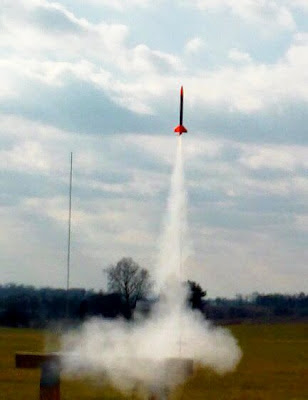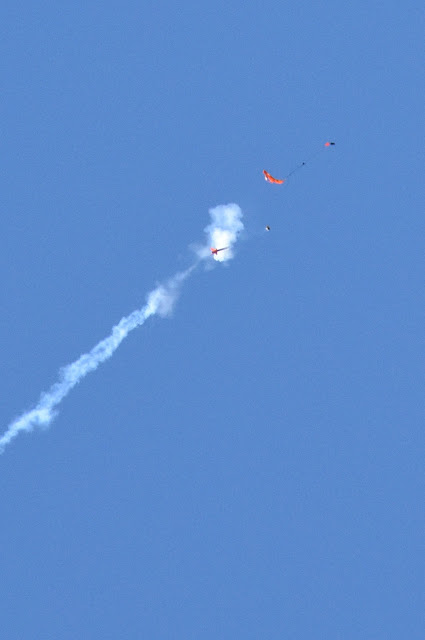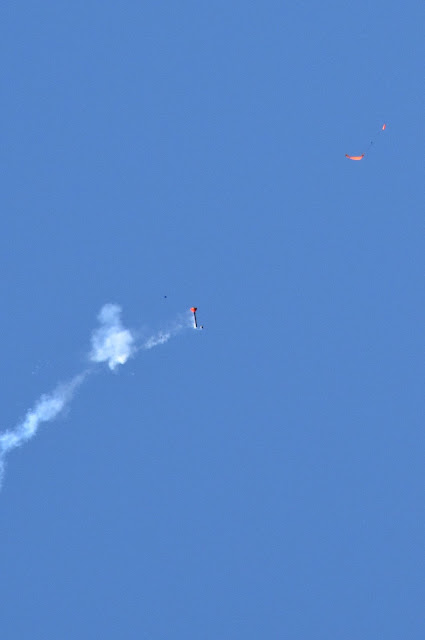I think this model could be called something else, but it came in a Quest starter kit and the other model was busted (I got a deal), so I used the "Cyclone" tube wrapper because it looked better, so now I just got used to calling it the Cyclone. It could just have well been called "Chain Reaction", the other decal.
I modified the streamer bay with vent holes to install an Altimeter One. Notice also, to break up the monotony of the plain orange fins, I added the cheesy stripes to the fins using leftover sticker material from the body wrap. (sorry, that can't be seen from these pictures :o| ) This model doesn't get much respect from me though; I didn't build it, just some minor assembly work.
Not only is it simple and colored ugly, the plastic fins means it is a toy. A real rocket has balsa or wood fins and paint! I must admit though, it flies fast and high and is pretty rugged. Between the molded but flexible fins and the extra-thick body tube, it is a virtual tank compared to other rockets - very kid friendly.
This rocket has flown higher than NASA's VAB (Vehicle Assembly Building) in Cape Kennedy Florida – and that was only with a B6-4! I have yet to send it up with a C6-7, it very well may never come back. I really would like to see how high it will go though; it would probably break the record currently held by the Sprint.
Flying on the B6-4 motor, this model holds the record for both altitude and speed, beating 13 other models. Its November 2012 flight reached a record 132 mph and 541 feet.
SPECIFICATIONS
Series Number: 13
Number of Stages: 1
Length: 12.68"
Diameter: apx. 5/8"
Empty Weight: 28.2 grams
Liftoff Weight Range: 50.1 - 59.3 grams
Motor Diameter: 18 mm
Motor Length: 70 mm
Motor Retention Method: Clip
Altimeter Capable: Yes (with streamer)
Streamer: 26" plastic
Recovery Protection: Wadding
Shock Cord Mount: Kevlar
Number of Fins: 4
Fin Material: Single-Piece Molded Plastic
Launch Lug Size: 1/8" molded in with fins
Kit Brand: Quest
Completed: November, 2010
FLIGHT LOGS
2010, November 13: Tanguy Soccer Field, Light wind
A8-3: Good Flight & Recovery. Went quite high, came down close with the streamer.
2011, October 2: Penn Manor, Breezy, cold, drizzly
B6-4: Tried a B motor on this ugly RTF. I didn't want to risk a built-up model in these winds with no other observers. She sailed very high and arced over while coasting upwind quite a distance. For this weight I predicted & estimated over 500 feet - I'll say 530.
Fortunately the streamer deployed and she fell straight down with little drift. This was an impressive, fast and flawless flight.
2012, February 5: Penn Manor, 5-10 mph wind
A8-3: This windy day was no good for high flights or precious rockets, so I sent this RTF model up with an altimeter on a small A8-3 motor to get some new data on its flight abilities. The molded launch lug is a bit loose for a 1/8" rod, so it wobbled quite a bit after ignition while on the rail. It burned for 6/10 second, accelerated at 13 Gs and averaged 5.6 Gs for the burn. In that time it reached 68mph and 216 feet apogee.
The supplied thick and short plastic streamer did not fully release or even leave the tube completely in the 40-degree weather so it came down fast. The wadding was still stuck in the tube - a bit too tight. Still, safe recovery and ready for more flying. Ejection was at 202 feet and it descended at 13 mph for a total flight time of 13.1 seconds.
B6-4: After a successful flight with an A8, it was time to measure this RTF with a B6 motor. It was windy and cold, so I could expect the rocket to weathercock and the streamer to freeze up - both of which came true but as an RTF model I didn't care as long as I got my Altimeter 2 back alive.
The B6-4 burned for 9/10 second and accelerated at 17.8 Gs (fast!), averaging 7.1 Gs for the boost. It sped the rocket to 132 mph (the fastest measurement yet for any rocket of mine). It reached an apogee of 541 feet (amazingly only 11 feet above my estimate for a previous B6-4 flight with this rocket! I guessed 530.) It had a 5 second coast to apogee, and a -1.3 apogee-to-ejection time, at 517 feet. That means that the ejection was early at 517 feet while coasting up for another 1.3 seconds before reaching 541 feet. A B6-6 would be a better choice for this model, where it might reach closer to 600 feet.
As expected in the cold weather, the stock plastic streamer didn't deploy, and in fact never made it out of the tube since it was so stiff from the cold, so it came down fast at 19 mph. The generous amount of wadding was also stuck behind the streamer, so the ejection gasses found their way around it and "warmed" up the streamer a bit (it was a bit melted and quite sooty).
2012, November 4: Penn Manor, 14mph winds, steady
B6-4: Often with this rocket in the cold air, the thick plastic streamer gets stiff and doesn’t unfurl or gets stuck in the tube, so this time I packed it very carefully, only satisfied on my third attempt to squeeze it and the shock cord and the Altimeter Two into the small body tube. This time I noticed the wobble of the rocket on the launch rail because the molded plastic lug is too large, making a mental note to try a 3/16 rod next time. This is an odd lug size for such a small, light rocket.
It lifted off well and quickly accelerated at a peak of 20.1 Gs, averaging 7.2 Gs for the 0.9 second burn
of the motor. Very fast! It reached a speed of 137 mph and coasted for 4.3 seconds while flying at a
moderate angle into the wind.
Ejection occurred at 503 feet and it came to a peak of 536 feet with the streamer unrolling completely this time. The apogee was higher than any other rocket I have flown using the B6 motor, although it did not beat its own record of 541 feet. It did set a new speed record for the B6 motor though.
With the short streamer it fell to the ground at 19 mph. During that time I watched the strong winds carry it very far downwind. It landed about 350 feet downwind after a flight time of 23.5 seconds. Absolute success!
2013, March 10: Penn Manor, 5-15 mph winds, 63 degrees, 18%RH
B6-4: I would have used a -6 delay but the wind was quite strong. The Cyclone was deemed safe to fly in such winds because of its small streamer.
Ignition went well and the rocket shot off the pad at a strong 20.4 Gs, averaging 7.3 Gs for the B6’s 8/10 second burn time. Both the peak and average G-forces were higher than any previous flight. The motor burned for 8/10 seconds, letting the Cyclone reach a top speed of 131mph to coast for the next 3.4 seconds when the ejection fired. The ejection was measured at 477 feet, while the apogee of the rocket measured 9138 ! Obviously this was an altimeter measurement error, no rocket is going to go over 9000 feet on a B6 motor…on the Earth at least.
Similar to other flights, it seemed to reach the same apogee, so I’ll estimate this at 538 feet, which is the mean for this rocket. After a well-deployed streamer, this rocket returned at 20mph, landing downwind about 400 feet.
2013, October 6: Penn Manor (south field), 8 mph winds, 80 degrees
A8-3: As the motor came to life, this small rocket reached a peak acceleration of 16.6 Gs. During the 6/10 second burn, it averaged 5.7 Gs. The trajectory was straight up and very fast. It made a top speed of 71 mph before coasting for the next 3.3 seconds to an apogee of 221 feet.
The only picture I have of this flight, looking up at the launch.
I had two other cameras trained on the rocket, but I forgot to press record on one,
and the other one didn't "see" the press for unknown reasons.
I was testing out my new camerifle, and was able to track this flight perfectly, however I later discovered I forgot to press record before the flight. I was also recording the launch at 300 fps, and later discovered that the press of the record button was not detected. Murphy.
2016, September 3: Fort Indiantown Gap,
73 degrees, 10 mph wind, gusty.
A8-3: This was the fourth flight of the Cyclone with an A8 motor. Three of those
flights carried an Altimeter 2, but one had a stuck streamer and one did not give valid
ejection timing data. This particular flight went well and gave me a complete set of
numbers.
With a reliable ignition, it lept off the pad with an acceleration of 21.3 Gs, a record
high for any motor. It was gone quickly! The motor burned for ½ second – fast, and gave
me an average of 7.3 Gs, a record high for the A8 in this rocket. This pushed it to a
top speed of 72 mph (of course, a record high for the A8 in this rocket).
B6-4: Time to see how the Cyclone does with a B6 again. This has flown before with an
Altimeter 2 recording data, but one flight had a stuck streamer, and one had an obvious
altitude error of over 9000 feet. I only had one successful data flight for the B6, and
this was to be the second one.
flights carried an Altimeter 2, but one had a stuck streamer and one did not give valid
ejection timing data. This particular flight went well and gave me a complete set of
numbers.
With a reliable ignition, it lept off the pad with an acceleration of 21.3 Gs, a record
high for any motor. It was gone quickly! The motor burned for ½ second – fast, and gave
me an average of 7.3 Gs, a record high for the A8 in this rocket. This pushed it to a
top speed of 72 mph (of course, a record high for the A8 in this rocket).
The rocket then coasted for 2.6 seconds and still flew straight up despite the winds.
The 2.5 second delay was a bit too soon, firing off at 197 feet, stopping the rocket
1/10 second later at an apogee of 229 feet. Again, a record for the A8 motor.
I got a good streamer, and the rocket came back at 16 mph (interestingly, faster than
when the streamer was stuck). The duration of this flight was a mere 11.1 seconds when
it landed 100 feet downwind.
All in all a success, and told me 200+ feet was quite safe
on this windy day, at least with a streamer. On this day I saw many, many other club
member's rockets drift away into the trees to the west and into history. This rocket now earned a flight with a more powerful B6 motor.
B6-4: Time to see how the Cyclone does with a B6 again. This has flown before with an
Altimeter 2 recording data, but one flight had a stuck streamer, and one had an obvious
altitude error of over 9000 feet. I only had one successful data flight for the B6, and
this was to be the second one.
Just like before the Cyclone ripped off the pad, this time with the highest recorded acceleration of 23 Gs or more (which is the measure limit of the Altimeter). With a burn time of 8/10 seconds, the average acceleration of 7.7 Gs was also an all-time
record. Naturally, this reached a record speed of 142 mph, and set an altitude record
of 582 feet.
It was visually obvious that this rocket flew very high and very straight up. Fortunately it has some highly visible orange on it and a clear blue sky making it easy to track.
The ejection seen above shows the streamer and shock cord attached to the nose cone and altimeter. Attached in between is the motor block. The body tube is in the smoke. The remaining piece is wadding. At close to 600 feet high, it was not apparent that the two were separated.
Here it seems obvious that the two were not connected, but all eyes were tracking the easy to spot streamer. Nobody noticed the body tube separation and it falling by itself.
At 554 feet, the ejection charge fired after a generous 2/10 extra time; still not
enough given the high speed this rocket achieved. It climbed its last 28 feet with the
streamer opening up completely. It returned at an expected rate of 16 mph. That was a
record flight time of 28.4 seconds.
I went to retrieve the rocket, seeing exactly where it landed, about 300 feet downwind.
As I approached the orange blur on the ground, it turned out to be just a dull orange
clump of grass. Here goes an afternoon of searching! I quickly located the actual
streamer another 50 feet further. I arrived and found the orange streamer, orange nose
cone and fortunately the Altimeter safe and sound, but there was no purple/black rocket
body, and I realized I may never see it again.
I found the rocket body a short time later about 50 feet upwind, fortunately I didn’t
step on it walking to the streamer. (I just did that to the Bullpup 12D after it was
prepped for a flight. It would have flown with this motor in it.)
Apparently what happened is that the ejection and possibly the streamer deploying in
the 100+ mph wind pulled the motor block out of the body tube, as it was still attached
to the Kevlar shock cord. There was no sign of glue on the block, or in the body tube,
and no sign of torn cardboard, only a slight indentation the size of the motor clip
end.
This was an almost-ready-to fly kit, and I don’t recall the build exactly, but I know
for sure I would not have installed the motor block without any glue, so that may have
been already made. It might be a simple fix, but not sure the glue will hold with all
the charred soot in the body tube from 9 flights so far. Maybe a good cleaning and
sanding first would help. Right now, this rocket is in “Needs Repair” status, so there
will be no more scheduled flights.
Above is a view down the body tube towards the fins. Other than some ash deposit and the bit of metal motor clip, there appears to be nothing left in the tube, and no damage.
This next view looking up into the motor mount lit by the sunlight, we see nothing at all except for the ash deposits starting where the top of the motor ends. It doesn't appear that there was any glue or damage to the cardboard from failed glue.
In the above photo of the motor block, the outer green layer of paper is clearly unglued and undamaged. The ejection charge must have simply yanked the block clear out of the tube after it deformed a bit.
#Quest #modelrocket #rocket #cyclone #chainreaction

















No comments:
Post a Comment